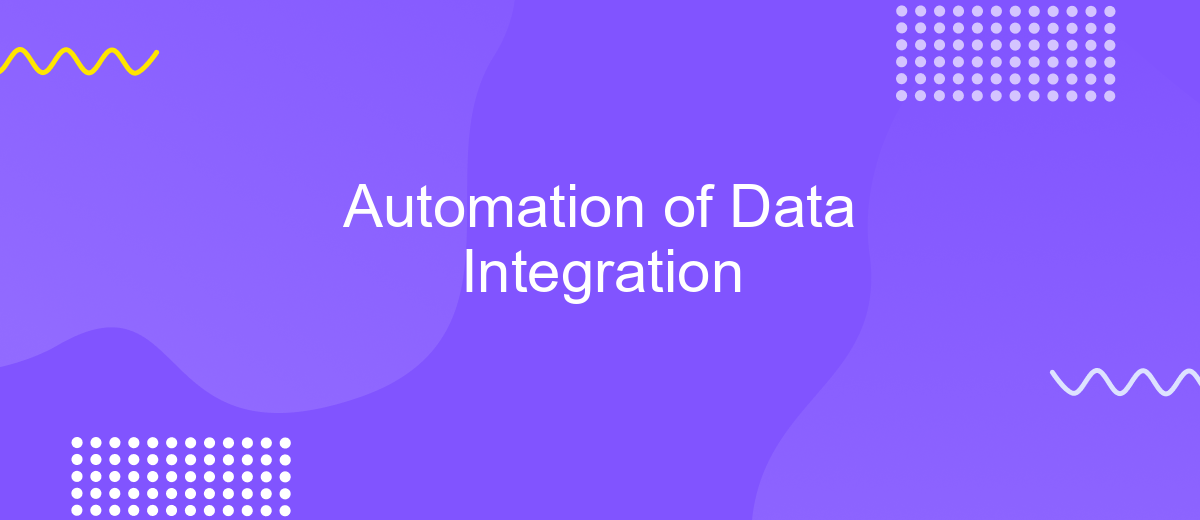Automation of Data Integration
In today's data-driven world, the automation of data integration has become essential for businesses seeking efficiency and accuracy. By automating the process, organizations can seamlessly merge disparate data sources, reduce manual errors, and accelerate decision-making. This article explores the benefits, challenges, and best practices of automating data integration to help companies stay competitive and agile in an ever-evolving landscape.
Introduction
In today's data-driven world, the ability to seamlessly integrate data from various sources has become a critical component for businesses. Automation of data integration processes not only enhances efficiency but also ensures data consistency and accuracy. As organizations continue to accumulate vast amounts of data, traditional manual methods of data integration are proving to be inadequate, leading to the growing importance of automated solutions.
- Reduction in manual errors
- Improved data quality
- Faster data processing
- Enhanced scalability
- Cost-effectiveness
Automating data integration involves leveraging advanced tools and technologies to streamline the collection, transformation, and loading of data. This process enables organizations to make informed decisions quickly and efficiently by providing real-time access to integrated data. As we delve deeper into the subject, we will explore various techniques and best practices for implementing automated data integration solutions, highlighting their benefits and potential challenges.
Challenges and Limitations

Automation of data integration presents several challenges and limitations. One significant challenge is the compatibility between different data sources and systems. Each system may have its own data formats, protocols, and standards, making seamless integration difficult. Additionally, data quality issues such as inconsistencies, duplicates, and errors can complicate the automation process, requiring robust data cleansing and validation mechanisms. Furthermore, security concerns arise when integrating sensitive data across multiple platforms, necessitating stringent security measures to protect against data breaches and unauthorized access.
Another limitation is the complexity involved in setting up and maintaining automated data integration workflows. While services like ApiX-Drive can simplify the process by providing pre-built connectors and intuitive interfaces, the initial configuration and ongoing management can still be resource-intensive. Scalability is also a concern, as increasing data volumes and integration points may require significant infrastructure upgrades. Moreover, the lack of standardization in APIs and integration protocols can lead to vendor lock-in and reduced flexibility, limiting the ability to adapt to changing business needs.
Technology Overview

Automation of data integration leverages advanced technologies to streamline the process of combining data from various sources into a unified view. This integration is crucial for businesses to gain comprehensive insights and make informed decisions. By utilizing automation, organizations can reduce manual effort, minimize errors, and accelerate the data integration process.
1. **ETL Tools**: Extract, Transform, Load (ETL) tools automate the extraction of data from different sources, its transformation into a suitable format, and loading it into a data warehouse.
2. **APIs**: Application Programming Interfaces (APIs) enable seamless communication between different software systems, facilitating real-time data integration.
3. **Data Integration Platforms**: These platforms offer a centralized solution for managing data integration processes, providing features like data mapping, cleansing, and monitoring.
4. **Cloud Services**: Cloud-based data integration services offer scalability and flexibility, allowing businesses to handle large volumes of data efficiently.
Implementing automation in data integration not only enhances data accuracy and consistency but also frees up valuable resources for more strategic tasks. As technology continues to evolve, the capabilities of automated data integration will further expand, providing even greater benefits to organizations across various industries.
Implementation Strategies

Implementing data integration automation involves several strategic steps that ensure seamless and efficient data flow across various systems. A well-planned approach not only reduces manual effort but also enhances data accuracy and timeliness, which are crucial for informed decision-making.
First, it is essential to assess the current data landscape, identifying all data sources, formats, and integration points. This assessment helps in understanding the complexity and scope of the integration task. Next, selecting the right tools and technologies is crucial. These tools should support the required data formats, have robust data transformation capabilities, and offer compatibility with existing systems.
- Define clear integration objectives and goals.
- Choose scalable and flexible integration tools.
- Ensure data quality and consistency through validation mechanisms.
- Implement continuous monitoring and logging for troubleshooting.
- Establish robust security protocols to protect data integrity.
Finally, it is important to train the team on the new automation processes and tools. Regular updates and feedback loops can help in refining the integration strategy over time, ensuring that the system adapts to evolving business needs and technological advancements.


Case Studies and Best Practices
In recent years, numerous companies have successfully implemented automation in their data integration processes, yielding impressive results. For instance, a major e-commerce company streamlined its data flow between various platforms using ApiX-Drive. This service enabled seamless integration between their CRM, email marketing, and inventory management systems, reducing manual data entry errors and significantly improving operational efficiency. The automation not only saved time but also allowed the company to focus more on strategic decision-making and customer engagement.
Another best practice involves a healthcare provider who utilized ApiX-Drive to automate data transfers between patient management systems and billing software. By integrating these critical systems, they minimized administrative overhead and ensured accurate, real-time data synchronization. This led to faster billing cycles and improved patient satisfaction. These case studies highlight the importance of selecting robust integration tools like ApiX-Drive to enhance data accuracy, reduce operational costs, and drive overall business growth through automation.
FAQ
What is data integration automation?
How does data integration automation benefit businesses?
What are the key features to look for in a data integration automation tool?
How can I ensure the security of my data during automated integration?
Can I integrate data from multiple sources without coding skills?
Strive to take your business to the next level, achieve your goals faster and more efficiently? Apix-Drive is your reliable assistant for these tasks. An online service and application connector will help you automate key business processes and get rid of the routine. You and your employees will free up time for important core tasks. Try Apix-Drive features for free to see the effectiveness of the online connector for yourself.

